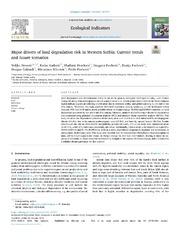Приказ основних података о документу
Major drivers of land degradation risk in Western Serbia: Current trends and future scenarios
| dc.creator | Perović, Veljko | |
| dc.creator | Kadović, Ratko | |
| dc.creator | Đurđević, Vladimir | |
| dc.creator | Pavlović, Dragana | |
| dc.creator | Matić, Marija | |
| dc.creator | Čakmak, Dragan | |
| dc.creator | Mitrović, Miroslava | |
| dc.creator | Pavlović, Pavle | |
| dc.date.accessioned | 2021-04-27T08:52:13Z | |
| dc.date.available | 2021-04-27T08:52:13Z | |
| dc.date.issued | 2021 | |
| dc.identifier.issn | 1470-160X | |
| dc.identifier.uri | https://radar.ibiss.bg.ac.rs/handle/123456789/4206 | |
| dc.description.abstract | Land degradation and desertification (LDD) is one of the greatest ecological challenges of today, with climate change resulting from anthropogenic factors a major cause of it. Recent projections of LDD in the Mediterranean region indicate a gradual widening of arid areas due to increased aridity and global warming by the end of the 21st century. Therefore, this study used the MEDALUS method to identify sensitivity to LDD in Western Serbia between 1986 and 2005 and to assess possible effects of climate change (RCP4.5 and RCP8.5 scenarios) on land degradation processes by the end of the 21st century. Likewise, analysis of possible major drivers of degradation was conducted using principal component analysis (PCA) and multiple linear regression analysis (MLRA). The study revealed that degradation processes in the study area were found to be most influenced by anthropogenic drivers (34.4%), less so by natural/anthropogenic ones (23.5%), and least by natural factors (20.1%). Results also showed that critical areas of LDD susceptibility account for nearly 37% of the study area, transitional areas cover 35%, while 27% constitutes potentially safe areas. Additionally, critical areas were projected to expand by 33.6% (RCP4.5) and 51.7% (RCP8.5) by 2100 as a result of predicted temperature increases and a reduction in precipitation in the study area. This study also revealed that the Standardised Precipitation-Evapotranspiration Index (SPEI) better explains the impact of climate change on LDD than other indices, bearing in mind the capacity of this index to detect temporal oscillations in drought in the context of climate change, and it is therefore a reliable climate parameter for this method. | |
| dc.publisher | Elsevier B.V. | |
| dc.relation | info:eu-repo/grantAgreement/MESTD/inst-2020/200007/RS// | |
| dc.rights | openAccess | |
| dc.rights.uri | https://creativecommons.org/licenses/by-nc-nd/4.0/ | |
| dc.source | Ecological Indicators | |
| dc.subject | Climate change | |
| dc.subject | Drivers | |
| dc.subject | LDD | |
| dc.subject | MEDALUS | |
| dc.subject | SPEI | |
| dc.title | Major drivers of land degradation risk in Western Serbia: Current trends and future scenarios | |
| dc.type | article | en |
| dc.rights.license | BY-NC-ND | |
| dcterms.abstract | Павловић, Марија; Перовић, Вељко; Кадовић, Ратко; Ђурђевић, Владимир; Павловић, Драгана; Чакмак, Драган; Митровић, Мирослава; Павловић, Павле; | |
| dc.rights.holder | ©2021 by The Authors. Published by Elsevier Ltd. | |
| dc.citation.volume | 123 | |
| dc.identifier.doi | 10.1016/j.ecolind.2021.107377 | |
| dc.identifier.scopus | 2-s2.0-85099614552 | |
| dc.identifier.wos | 000615921800003 | |
| dc.citation.apa | Perović, V., Kadović, R., Đurđević, V., Pavlović, D., Pavlović, M., Čakmak, D., et al. (2021). Major drivers of land degradation risk in Western Serbia: Current trends and future scenarios. Ecological Indicators, 123, 107377. | |
| dc.citation.vancouver | Perović V, Kadović R, Đurđević V, Pavlović D, Pavlović M, Čakmak D, Mitrović M, Pavlović P. Major drivers of land degradation risk in Western Serbia: Current trends and future scenarios. Ecol Indic. 2021;123:107377. | |
| dc.citation.spage | 107377 | |
| dc.type.version | publishedVersion | |
| dc.identifier.fulltext | https://radar.ibiss.bg.ac.rs/bitstream/id/8411/1-s2.0-S1470160X2100042X-main.pdf | |
| dc.citation.rank | M21 |

